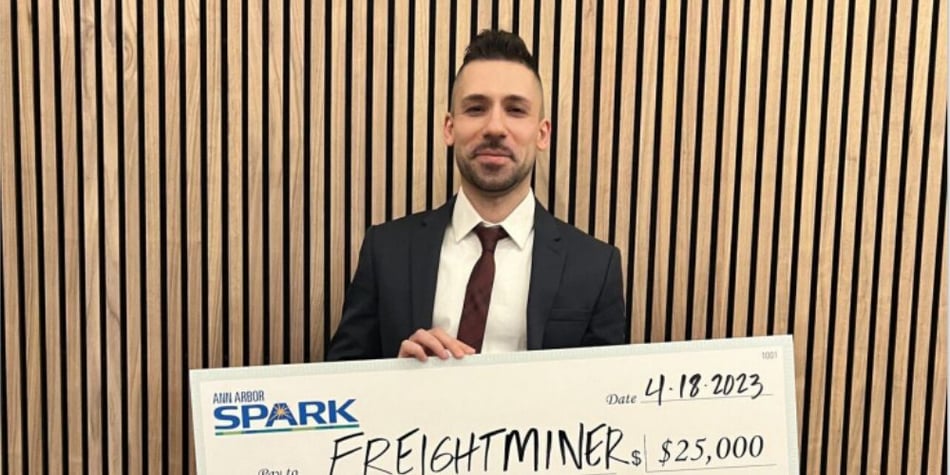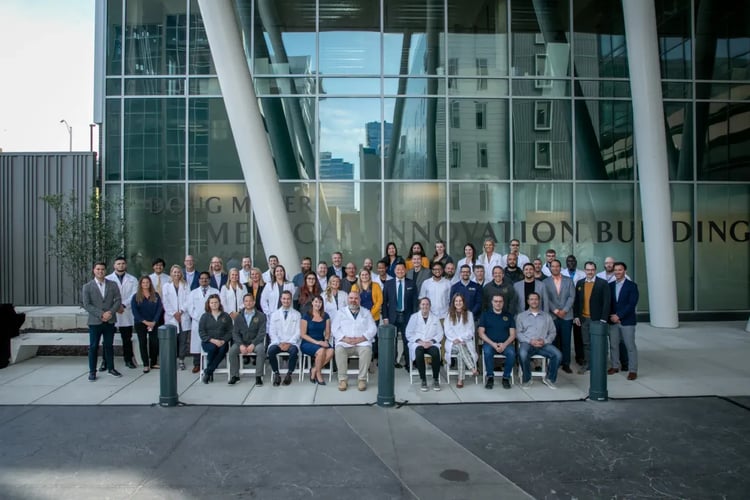At this year’s North American International Auto Show in Detroit, artificial intelligence will no doubt take center stage. From Big Three showcases to startup technology like May Mobility, companies will be showing off the latest technology in autonomous driving.
There’s one company that’s taking it a step further.
FreightMiner, an early-stage startup based in Ann Arbor, is developing autonomous driving technologies that enable commercial fleet trucks to operate entirely without a driver.
Currently, there’s two types of unmanned vehicle technology: teleoperation and robot driving. Teleoperation places systems in the vehicle that enable a human to remotely control it. Robot driving, which is still heavily in testing and not widely deployed, is total autonomous driving without the interference of a human. Because of the obvious and severe safety issues, this type of autonomous driving is limited, and the technology requires clear weather and road conditions — which is a big problem when more than 85% of trucking movement is concentrated in the snow-belt region.
That’s why FreightMiner is taking a hybrid approach, employing both types of technology in an aftermarket teleoperated-autonomous driving conversion kit that can be up-fitted on existing supply trucks.
“With our hybrid approach, commercial trucks can be remotely operated during the beginning and the end of the drive portions, while being autonomously driven over the long-freeway stretch where most long-haul trucking companies confirmed the challenge of not having enough drivers,” says Al Houry, founder of FreightMiner.
This hybrid approach leverages remote operations to handle complicated driving tasks outside highway roads, which is much more complicated due to traffic lights, pedestrians, city streets and traffic. Highways are less complex and allow for easier autonomous driving.
Unlike most, if not all, current autonomous driving systems today that rely heavily on vision cameras as the primary sensors of choice, FreightMiner uses alternative sensor technologies such as Lidars, Radars, and thermal cameras, which operate better in dense fog, heavy rain, snow, and nighttime.
.jpg?width=890&height=300&name=freight%20miner%20computer%20vision%20(890%20%C3%97%20300%20px).jpg)
Teleoperator's vision with standard vision cameras (left) versus FreightMiner's Superhuman vision (right)
“The cameras that other autonomous vehicles use are in fact not better than the human eye,” says Al. “Our kit allows truck teleoperators to gain superhuman-like vision capabilities that enable them to see visual cues highlighting surrounding objects and road edges in treacherous terrains under most weather conditions even during dense fog, night time, and on snow-covered roads.”
While highways may not be so treacherous, there’s another use-case FreightMiner is targeting: the military.
One of the most dangerous jobs in the military is ground transportation. Military truck drivers are severely at-risk in times of combat. Additionally, autonomous military supply trucks might not even have a map to rely on and often have to traverse treacherous terrains. With FreightMiner’s technology, military truck teleoperators will be able to gain superhuman-like vision in order to operate these trucks on most terrains during most weather conditions — even at night time, which helps reduce the chances of attacks and other safety risks.
Military Supply Trucking, image courtesy of FreightMiner
“As our approach can easily be adopted for military use, we’re targeting the Department of Defense to help them reduce their costs and also reduce human risk. This market is extraordinarily large and we plan to be part of it,” says Al.
Military aside, the U.S. general freight market alone was estimated to be around $91 billion in 2022. The market for autonomous trucking was valued at $2.6 billion in 2022 and is projected to reach $8.5 billion by 2030.
“We’re initially targeting small- to medium-sized trucking companies, and will eventually target national and international trucking companies. We expect to be able to scale very fast and address a large segment of the trucking industry,” Al says.
Why would FreightMiner technology be a benefit to small trucking companies? Because they’re the ones hurting the most.
According to Al, about 90% of the trucking industry consists of small owner-operators who can’t keep up with the rising costs of gas and maintenance. They also don’t have large fleets like larger trucking companies, so if a truck is out of service, the company doesn’t make money. They also don’t have enough drivers.
When these trucks are driven by human drivers, the operating time by law is limited to 11 hours a day. Multiple in-cab drivers per truck could help, but then driver costs would multiply. Fully autonomous driving technologies still require an in-cab safety driver on surface streets, so FreightMiner’s hybrid approach is especially important.
“About 70% of the freight industry is trucking, and if 90% of that is hurting, that’s a huge problem,” says Al. “We want to take the money owners have to pay for a truck driver, and put that back into their pockets. We’re not replacing jobs. We’re coming in and filling the void, resolving challenges for these smaller businesses.”
Additionally, these small trucking companies can’t afford to buy these expensive, next-generation autonomous trucks. By using existing trucks, FreightMiner is unlocking all of the benefits of this new technology, at a much lower cost.
“Our method of upfitting and controlling production trucks with hardware without voiding manufacturer’s warranty is a novel approach,” says Al.
As FreightMiner continues to develop its prototype, test its vehicle integration, and develop an MVP, the company has intentionally set up shop in Ann Arbor, with the help of Ann Arbor SPARK.

Image courtesy of Al Houry
“We wanted to develop a solution where the problem exists: the snow-belt region. We know that we needed to be founded in the Midwest. The state of Michigan has been nationally leading in mobility and transportation innovation. And the city of Ann Arbor has grown to become the leading city where entrepreneurs choose to found their companies,” says Al.
In addition to working with Ann Arbor SPARK, FreightMiner has a partnership with the MI SBDC office that supports entrepreneurial programs offered by Ann Arbor SPARK, such as coaching, problem identification, customer discovery, business strategy, and networking.
“Working with both SPARK and SBDC has opened us many doors to network with like-minded entrepreneurs in the Ann Arbor/Washtenaw County area and to learn from their experiences and synergize with them,” says Al.
FreightMiner also joined SPARK’s bootcamp program in the Spring 2023 cohort. The company was selected for first place in the Best of Bootcamp competition where they competed against the top three seasoned startups in the cohort and won $25,000. FreightMiner is continuing to enroll in other accelerator programs and competing in autonomy programs for the Department of Defense.
But the biggest events on their immediate schedule is the North American International Auto Show and Ann Arbor SPARK’s a2Tech360 event, part of the Tech Trek.
“Thanks to SPARK’s generous support, we plan to exhibit in this year’s North American International Auto Show, and Automobili-D specifically, where we will get to interface with industry experts on the floor at the showroom and invite them to learn more about what we are building at FreightMiner,” says Al. “We are very thankful to Ann Arbor SPARK for this opportunity and we are super excited to be participating in this iconic event.”
If you’re attending the auto show, be sure to find FreightMiner in Ann Arbor SPARK’s booth (#109), check out their simulator, and chat with Al about the cutting-edge technology.






